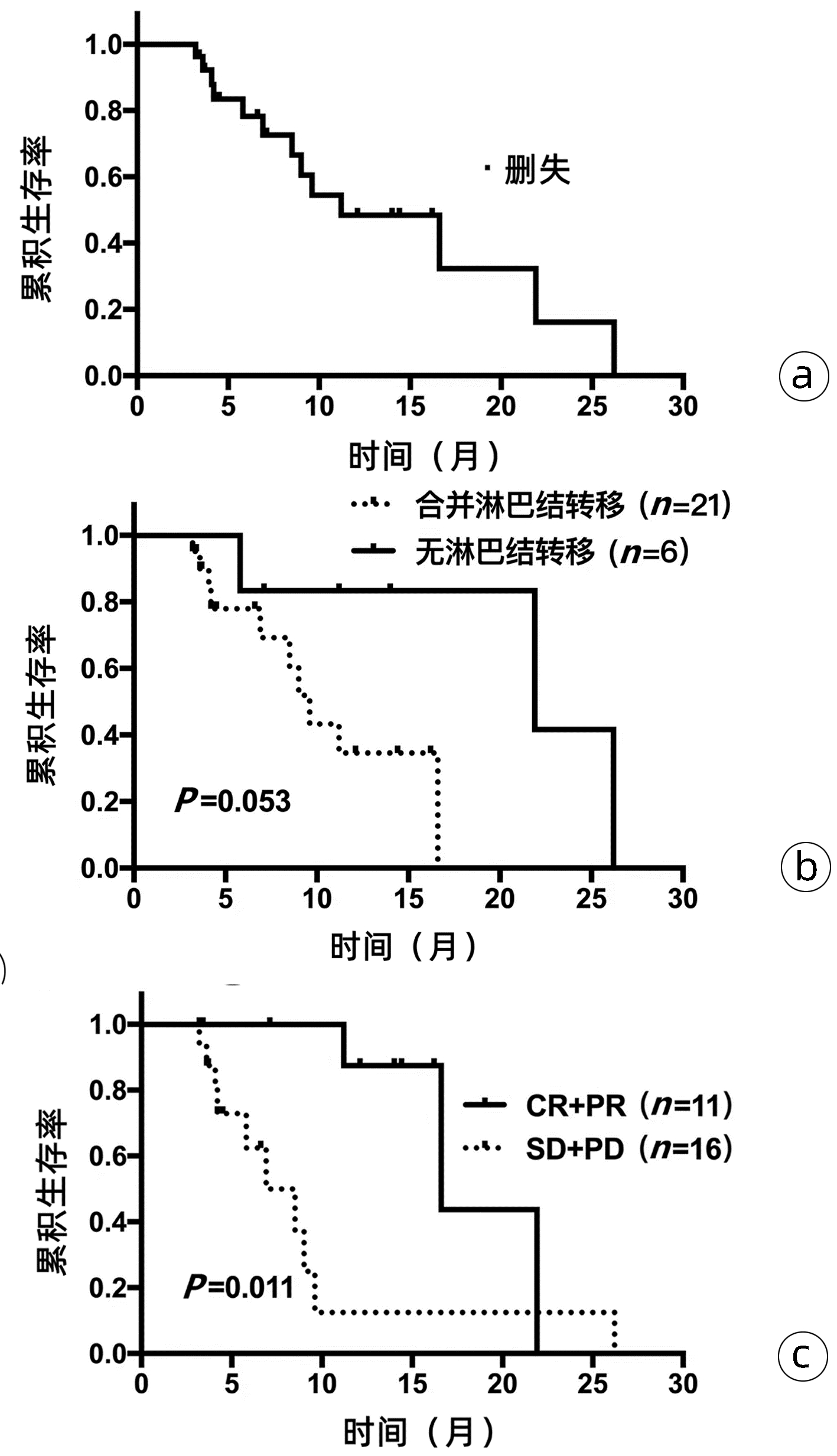| [1] |
KHAN SA, TAVOLARI S, BRANDI G. Cholangiocarcinoma: Epidemiology and risk factors[J]. Liver Int, 2019, 39 (Suppl 1): 19-31. DOI: 10.1111/liv.14095. |
| [2] |
BERTUCCIO P, MALVEZZI M, CARIOLI G, et al. Global trends in mortality from intrahepatic and extrahepatic cholangiocarcinoma[J]. J Hepatol, 2019, 71(1): 104-114. DOI: 10.1016/j.jhep.2019.03.013. |
| [3] |
|
| [4] |
VALLE J, WASAN H, PALMER DH, et al. Cisplatin plus gemcitabine versus gemcitabine for biliary tract cancer[J]. N Engl J Med, 2010, 362(14): 1273-1281. DOI: 10.1056/NEJMoa0908721. |
| [5] |
VALLE JW, FURUSE J, JITLAL M, et al. Cisplatin and gemcitabine for advanced biliary tract cancer: a meta-analysis of two randomised trials[J]. Ann Oncol, 2014, 25(2): 391-398. DOI: 10.1093/annonc/mdt540. |
| [6] |
LAMARCA A, PALMER DH, WASAN HS, et al. Second-line FOLFOX chemotherapy versus active symptom control for advanced biliary tract cancer (ABC-06): a phase 3, open-label, randomised, controlled trial[J]. Lancet Oncol, 2021, 22(5): 690-701. DOI: 10.1016/S1470-2045(21)00027-9. |
| [7] |
FINN RS, IKEDA M, ZHU AX, et. al. Phase Ib study of lenvatinib plus pembrolizumab in patients with unresectable hepatocellular carcinoma[J]. J Clin Oncol, 2020, 38(26): 2960-2970. DOI: 10.1200/JCO.20.00808. |
| [8] |
KUDO M, IKEDA M, MOTOMURA K, et al. A phase Ib study of lenvatinib (LEN) plus nivolumab (NⅣ) in patients (pts) with unresectable hepatocellular carcinoma (uHCC): Study 117[J]. J Clin Oncol, 2020, 38(4_suppl): 513. DOI: 10.1200/JCO.2020.38.4_suppl.513. |
| [9] |
LEE AJ, CHUN YS. Intrahepatic cholangiocarcinoma: the AJCC/UICC 8th edition updates[J]. Chin Clin Oncol, 2018, 7(5): 52. DOI: 10.21037/cco.2018.07.03. |
| [10] |
MAKAR AB, MCMARTIN KE, PALESE M, et al. Formate assay in body fluids: application in methanol poisoning[J]. Biochem Med, 1975, 13(2): 117-126. DOI: 10.1016/0006-2944(75)90147-7. |
| [11] |
BRANDI G, RIZZO A, DALL'OLIO FG, et al. Percutaneous radiofrequency ablation in intrahepatic cholangiocarcinoma: a retrospective single-center experience[J]. Int J Hyperthermia, 2020, 37(1): 479-485. DOI: 10.1080/02656736.2020.1763484. |
| [12] |
YOSHIKAWA D, OJIMA H, IWASAKI M, et al. Clinicopathological and prognostic significance of EGFR, VEGF, and HER2 expression in cholangiocarcinoma[J]. Br J Cancer, 2008, 98(2): 418-425. DOI: 10.1038/sj.bjc.6604129. |
| [13] |
XU YF, YANG XQ, LU XF, et al. Fibroblast growth factor receptor 4 promotes progression and correlates to poor prognosis in cholangiocarcinoma[J]. Biochem Biophys Res Commun, 2014, 446(1): 54-60. DOI: 10.1016/j.bbrc.2014.02.050. |
| [14] |
BOONJARASPINYO S, BOONMARS T, WU Z, et al. Platelet-derived growth factor may be a potential diagnostic and prognostic marker for cholangiocarcinoma[J]. Tumour Biol, 2012, 33(5): 1785-1802. DOI: 10.1007/s13277-012-0438-8. |
| [15] |
TOHYAMA O, MATSUI J, KODAMA K, et al. Antitumor activity of lenvatinib (e7080): an angiogenesis inhibitor that targets multiple receptor tyrosine kinases in preclinical human thyroid cancer models[J]. J Thyroid Res, 2014, 2014: 638747. DOI: 10.1155/2014/638747. |
| [16] |
KIMURA T, KATO Y, OZAWA Y, et al. Immunomodulatory activity of lenvatinib contributes to antitumor activity in the Hepa1-6 hepatocellular carcinoma model[J]. Cancer Sci, 2018, 109(12): 3993-4002. DOI: 10.1111/cas.13806. |
| [17] |
FINN RS, IKEDA M, ZHU AX, et al. Phase Ib study of lenvatinib plus pembrolizumab in patients with unresectable hepatocellular carcinoma[J]. J Clin Oncol, 2020, 38(26): 2960-2970. DOI: 10.1200/JCO.20.00808. |
| [18] |
UENO M, IKEDA M, SASAKI T, et al. Phase 2 study of lenvatinib monotherapy as second-line treatment in unresectable biliary tract cancer: primary analysis results[J]. BMC Cancer, 2020, 20(1): 1105. DOI: 10.1186/s12885-020-07365-4. |
| [19] |
O'MALLEY DM, BARIANI GM, CASSIER PA, et al. Pembrolizumab in patients with microsatellite instability-high advanced endometrial cancer: results from the KEYNOTE-158 study[J]. J Clin Oncol, 2022, 40(7): 752-761. DOI: 10.1200/JCO.21.01874. |
| [20] |
KIM RD, KIM DW, ALESE OB, et al. A phase lI study of nivolumab in patients with advanced refractory biliary tract cancers (BTC)[J]. J Clin Oncol, 2019, 37(15_suppl): 4097. DOI: 10.1200/JCO.2019.37.15_suppl.4097. |
| [21] |
LIN J, YANG X, LONG J, et al. Pembrolizumab combined with lenvatinib as non-first-line therapy in patients with refractory biliary tract carcinoma[J]. Hepatobiliary Surg Nutr, 2020, 9(4): 414-424. DOI: 0.21037/bsn-20-338. |
| [22] |
KATO Y, TABATA K, KIMURA T, et al. Lenvatinib plus anti-PD-1 antibody combination treatment activates CD8 + T cells through reduction of tumor-associated macrophage and activation of the interferon pathway[J]. PLoS One, 2019, 14(2): e0212513. DOI: 10.1371/journal.pone.0212513. |
| [23] |
ZHANG Q, LIU X, WEI S, et al. Lenvatinib plus PD-1 inhibitors as first-line treatment in patients with unresectable biliary tract cancer: A single-arm, open-label, phase ii study[J]. Front Oncol, 2021, 11: 751391. DOI: 10.3389/fonc.2021.751391. |








 DownLoad:
DownLoad:

